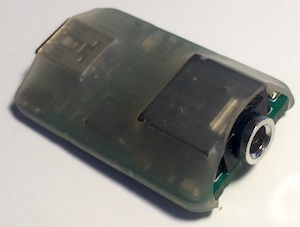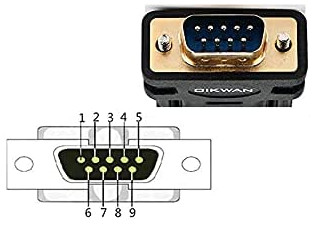 Morse Keyer 5.3.0 (Updated Nov 2024)
Morse Keyer 5.3.0 (Updated Nov 2024) Morse Keyer 5.3.0 (Updated Nov 2024)
Morse Keyer 5.3.0 (Updated Nov 2024)Morse Keyer is a software keyer that can output CW radio tones or old-fashioned telegraph sounder sounds, and drive a device via a serial port (a physical telegraph sounder/loop or ham rig). This document will hopefully be all you need to get going. 5.2.1 supports 3rd party (eBay) VBand adapters.
Hover the mouse over the controls on the window to get hints on what they do.
The keyer has four modes: straight-key, semi-auto (bug), and two paddle-squeeze modes: ultimatic and iambic.
The straight key mode is simple, it produces sound in response to key or paddle presses.
The semi-automatic (bug) mode emulates a Vibroplex-type key. In this mode, both International/radio and American/telegraph code can be sent. The dit length is set via the code speed control, and is calculated for the so-called "PARIS" (or "MORSE") method for International code.
The ultimatic and iambic modes can be used to send only International/radio code, as they do not have the timing features needed for American Morse. The code speed control uses the so-called "PARIS" (or "MORSE") method to establish dit and dah lengths.
When the paddles are squeezed in Iambic mode, an alternating sequence of dits and dahs is produced, starting with the first lever pressed. The iambic mode is normally the "B" mode, which adds a trailing element if the paddle is released "early". Most people prefer this mode. Mode "A" can be selected if you're used to it. For more info on iambic keying, see Using an Iambic Paddle by Chuck Adams, K7QO and What's all this iambic keyer mode A and B stuff, anyhow? Note that there is a little indicator that will flash when the Iambic B mode has filled out a sequence for you.
As of V5.2 the keyer supports the Ultimatic keying mode, an alternative to Iambic, and probably the oldest squeeze keying mode. Chuck Olson, WB9KZY wrote about it in Just What is Ultimatic Mode?, and this article by Karl Fischer, DJ5IL All About Squeeze Keying covers Ultimatic and Iambic A and B, showing comparisons. In Ultimatic mode, when the levers are squeezed, it sends at least one element from the first lever pressed, followed by a string of elements from the last lever pressed. Squeezing dit then dah produces dit-dah-dah-dah... Squeezing dah then dit generates dah-dit-dit-dit...
The keyer can be keyed with left and right mouse buttons, or a straight key, single-level, or iambic paddle attached to a serial port (via the CTS and DSR signals) or via a Ham Radio Solutions VBand USB Paddle Adapter as well as some 3rd party adapters. A single-lever paddle is most useful when the keyer is set for semi-automatic (bug) mode. This allows you to send American Morse code like you would with a real bug. An iambic paddle is most useful when the keyer is in the iambic paddles mode, and is limited to International Morse code.

Ham Radio Solutions has designed and produced a nice little adapter that connects to a computer with an included mini USB cable, and has a 3.5mm TRS jack for the paddle / straight key connection. For $30 (as of July 2024) this is the most convenient way to connect your key or paddle to the keyer. There are also alternatives available on eBay and the Keyer now supports these as well. You can also use this to connect to their VBand internet CW service. It also works with several iOS Morse apps such as Morse-It. The adapter just acts as a keyboard and sends key signals for the left and right control keys. NOTE: The Keyer app must be in the foreground in order for the control-key signals to be sent to the keyer.
Note: As of October 2024, CWMorse.us offers a pre-built serial port USB to Key adapter that supports straight keying and all paddles modes. These appear to be well built and have been tested with Morse Keyer. This has the advantage of not needing the mouse cursor to be over the blue rectangle, however the debouncing is done inside the keyer by the program and may have tiny timing disturbances (if noticable, only at QRQ speeds).
Use a DB-9 connector, usually a female (the serial port on the PC will be male). Or use a USB to Serial converter, but be careful. Some of these converters, especially old cheap ones, and specifically Prolific-chip based ones, will not work on Windows 10 or 11. Find one with the FTDI chipset that says compatible with Windows 11. The image to the right shows the pins looking into the male, so as you would see them if soldering to the back of the female. The pins are:

| Line | Pin | Function |
|---|---|---|
| DTR | 4 | Manual key or paddle common |
| DSR | 6 | Manual key or dot paddle |
| CTS | 8 | Dash paddle |
| RTS | 7 | Sounder output |
| SG | 5 | Sounder ground |
To key with the mouse, you must move the cursor over the blue "mouse keying area" in the keyer's window. For semi-auto the left mouse button sends the dits at the selected speed, and the right mouse button sends a steady tone as long as it is pressed. In Iambic mode the left button sends dits and the right button sends dahs, both at the selected speed.
Note: As of October 2024, CWMorse.us offers a pre-built mouse USB to Key adapter that supports straight keying and all paddles modes. These appear to be well built and have been tested with Morse Keyer. As stated below, if you don't mind having to put the mouse cursor over the blue rectangle, this is the best way to interface as the OS does the deboucing in the kernel.
If you have an old mouse you can sacrifice, consider turning it into a mouse interface for your key or paddles. Try keying as above to make sure this mouse will work OK. Then open the mouse and locate where the left (manual or dits) and right button (dahs) microswitches attach to the PC board. You should be able to see that one side of each switch is connected together. This is the common. The other side of each switch will be your left and right connections. The key effectively closes the mouse button switches (connected in parallel to the switches). Solder wires to the PC board so the key parallels the mouse button switches.
This is actually the best way to connect a physical key as the signals coming into the system are conditioned for debouncing and very fast to react. The disadvantage is that you must put the cursor over the keying area as already mentioned.
You can select to have radio tone or telegraph sounder output (DirectX output only). If you select Radio Tone, clicking the up and down arrow in the Tone Freq. box will play a short tone at the new frequency. The raised-cosine envelopes prevent key clicks etc., minimizing junk sidebands, when used as audio input to a SSB rig to make CW. You can control the rise/fall times of the raised-cosine envelope of tones as well. If you select Telegraph Sounder, you can cycle through the available sounder sounds in the same way. At speeds above 30 wpm, the telegraph sounds can start to sound mushy. This is a limitation in the speed of the sound playing in Windows. Note that telegraph sounds are not supported when you are using ASIO output (see below).
If you want to use a sound output device ("sound card") other than the one currently selected in Windows, you can select it in the dropdown list. To use the one selected in Windows, select Primary Sound Driver. In addition, if your system has a special low-latency driver that conforms to the Steinberg Audio Stream Input/Output (ASIO) protocol, you can select that as well (though telegraph sounds are not supported). The advantage of ASIO is that, for high speed (QRQ) sending, the delay between your keying and the audio you hear is reduced compared to that for the normal DirectX sound output. Even if your sound driver doesn't natively support ASIO, you may be able to reduce your sound feedback latency via the ASIO4ALL universal ASIO driver for WDM Audio.
First you need to make up an interface circuit which uses the serial port's Request to Send (RTS) pin to control the current loop that drives the sounder or loop. See the pinouts above for DB-9. You can find out more at Les Kerr's MorseKOB Interface Techniques page. Once you have the sounder interface connected, select your COM port and click Test button. Your sounder should click/clack 4 times or your ham rig should send 4 dits. If this works, you're all set. Check the Use box. When the serial port is active, the keyer always keys the DTR pin whether or not you have anything hooked up to it! If you don't want the keyer to make sounds, just turn the volume down to zero.
Morse Keyer was developed by Robert B. Denny. You can contact me at rdenny@dc3.com.
Thanks to Les Kerr, the MorseKOB author, and John Samin, author of CW Communicator, for help in getting this and other Morse code tools going. Please note that John Samin, author of CW Communicator, has retired from supporting the program. However, a gent from Portsmouth England has put up a CWCom support site called MorsePower.
As shown below, Morse Keyer is licensed as open source. Sources are available at the Morse Code RSS News Tools SourceForge Project.